
The Ultimate Guide to Outsourced Sales Management for B2B Revenue Growth

Sales representatives spend 70% of their time on non-selling tasks like admin work, CRM updates, and internal coordination. This slows down lead generation, increases sales costs, and delays conversions. For SMEs with limited bandwidth, these inefficiencies directly impact monthly recurring revenue (MRR).
Outsourced sales management offers a targeted solution to these challenges. It connects businesses with external specialists who run targeted campaigns and book meetings with qualified buyers. The model reduces internal effort while driving faster pipeline movement.
In this blog, we break down what outsourced sales management means, why it matters, and how it delivers real results. You’ll discover key benefits, when to consider it, and best practices for success.
TL;DR:
- Context matters: AI performs best when it understands your unique business, industry, and buyer behavior. Without context, it risks generating generic, ineffective outputs.
- One-size-fits-all doesn't convert: Whether it's messaging, targeting, or timing, AI still needs human direction to adapt strategies to your ICP and goals.
- Training data ≠ your brand voice: AI can assist with scale and speed, but it won’t replace tailored messaging that resonates with real decision-makers in your niche.
- Effective sales = dynamic learning: Sales involves nuance, objections, tone, timing. AI can support the process, but strategic thinking and adaptability still come from human leadership.
What Is Outsourced Sales Management?
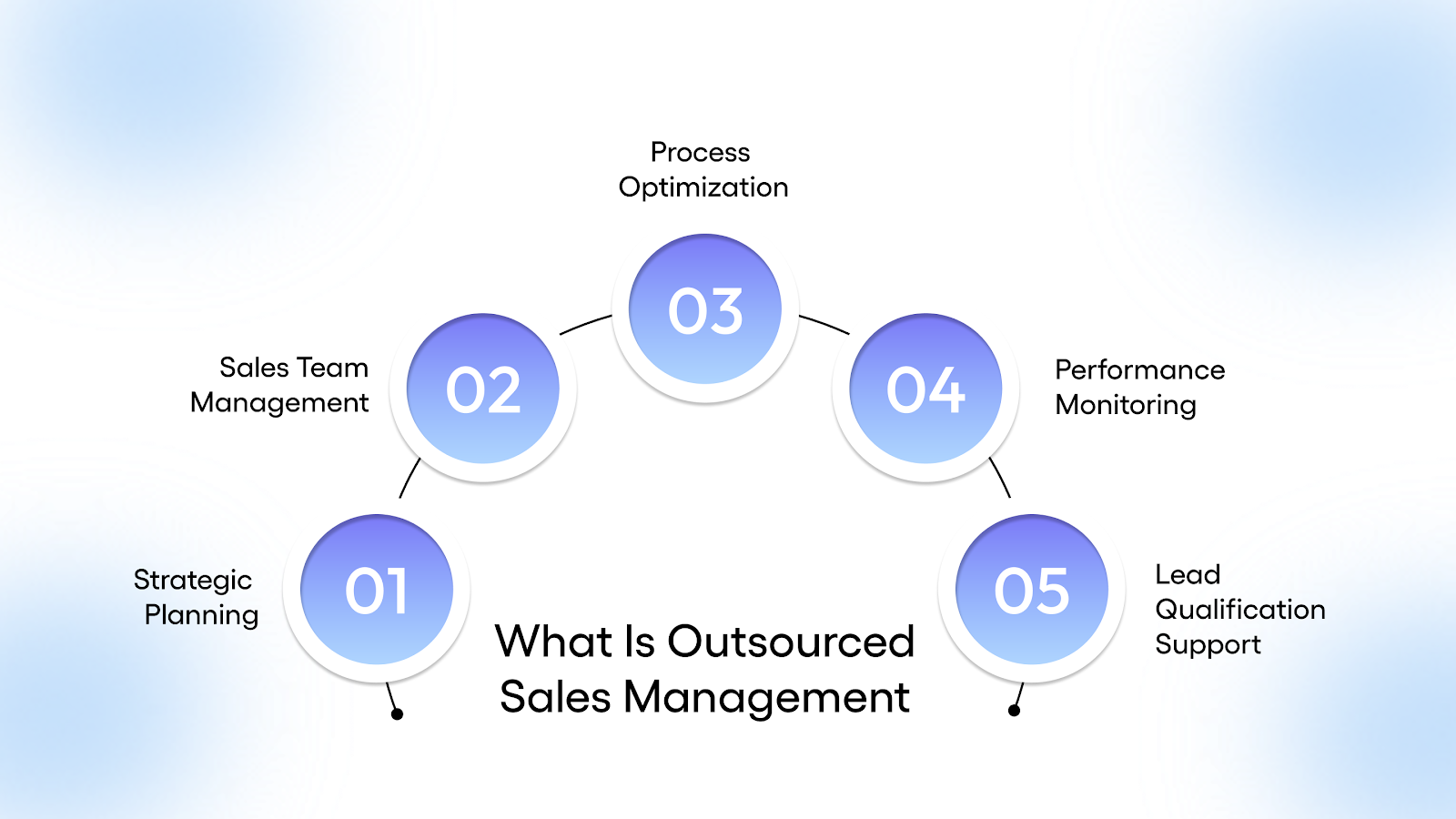
Outsourced sales management is the practice of partnering with an external team to oversee and optimize your sales operations. Instead of hiring, training, and managing an in-house sales leadership team, businesses delegate these functions to a third-party provider with deep B2B sales expertise.
This model is designed to support, not replace, your internal sales efforts. It typically encompasses top and mid-funnel activities, such as lead qualification, team performance monitoring, pipeline reviews, and sales forecasting. For SMEs, this setup provides experienced sales leadership without the overhead costs associated with building a full internal team.
Here’s what outsourced sales management typically involves:
- Strategic Planning and Oversight: Outsourced sales leaders craft go-to-market plans, set quotas, and align sales goals with company objectives.
- Sales Team Management: They coach, train, and monitor the performance of your existing sales team or a hybrid internal-external setup.
- Process Optimization: They streamline your reporting cadence and sales workflows for maximum efficiency.
- Performance Monitoring: Outsourced managers deliver regular insights into conversion metrics, pipeline health, and activity benchmarks.
- Lead Qualification Support: They ensure sales reps spend time only on qualified leads, reducing wasted efforts and accelerating results.
Two models are common in outsourced sales management:
- In the full department model, the provider supplies both the sales manager and the reps, handling recruitment, training, and payroll.
- In the management-only model, an external sales leader manages your internal team using remote tools and regular virtual check-ins.
This approach is ideal for fast-growing companies that want to drive revenue without delay. It gives access to experienced sales leadership, reduces onboarding time, and accelerates pipeline movement, all without adding fixed payroll costs.
Key Components of an Effective Outsourced Sales Model
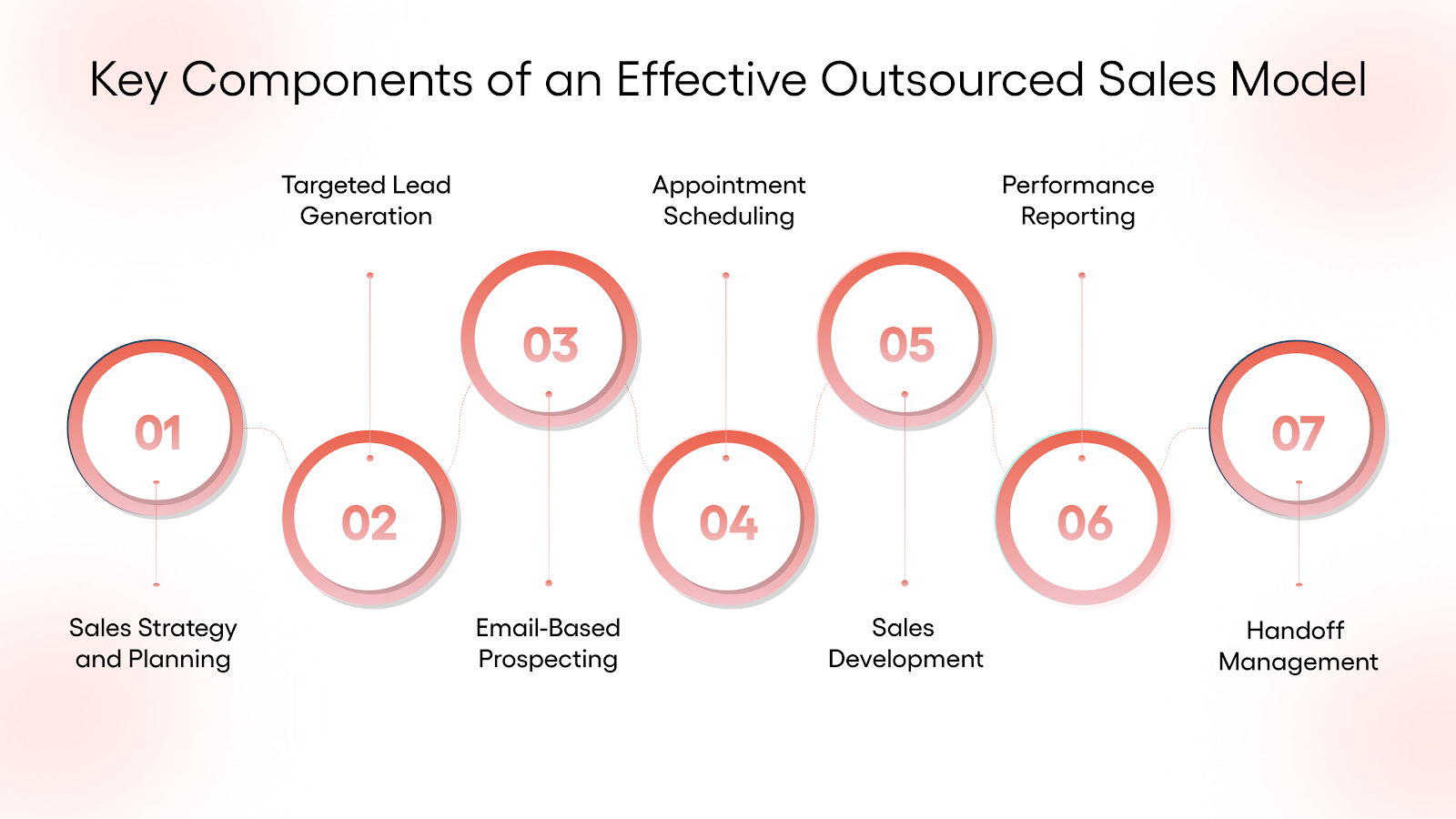
A successful outsourced sales model operates within a structured framework designed to improve sales outcomes, minimize inefficiencies, and expedite the path to revenue. Each component plays a distinct role in building a high-performing, scalable system.
Here’s a breakdown of the most critical elements included in a well-executed outsourced sales management setup:
Sales Strategy and Planning
The foundation begins with defining your Ideal Customer Profile (ICP), aligning sales goals with market demand, and mapping out outreach workflows. This step ensures every campaign targets the right audience with the right message.
A dedicated team researches and identifies decision-makers using firmographic and behavioral criteria. The goal is to surface only qualified leads that match your Ideal Customer Profile (ICP) and demonstrate intent to engage.
Email-Based Prospecting and Follow-Ups
Using custom email scripts and drip sequences, outsourced teams initiate conversations and maintain engagement. This approach eliminates the need for cold calling while preserving consistent outreach quality.
Appointment Scheduling with Decision-Makers
Qualified leads are converted into booked meetings through personalized outreach and persistent follow-up. This saves time for internal reps and accelerates movement through the funnel.
Sales Development and Pipeline Nurturing
Some providers also manage early-stage nurturing, keeping leads engaged until they’re ready for a sales conversation. This improves lead conversion without overburdening your in-house team.
Performance Reporting and Feedback Loops
Real-time dashboards and periodic reports provide visibility into campaign success. These insights are used to refine scripts, timing, and lead targeting to optimize results.
Deal Support and Handoff Management
Once prospects are engaged and qualified, outsourced teams ensure seamless handoff to internal sales or account executives, maintaining a consistent experience across touchpoints.
Each of these components works together to improve operational efficiency, deliver higher-quality leads, and increase your team’s capacity to close deals. When tailored to your business goals, an outsourced sales model becomes a long-term engine for MRR growth.
Top Benefits of Outsourced Sales Management for B2B SMEs
Small and mid-sized B2B businesses in sectors like IT, SaaS, staffing, and manufacturing often struggle to maintain efficient sales operations. Resource constraints, high hiring costs, and a lack of strategic sales leadership make it more challenging to achieve growth targets.
Outsourced sales management offers a practical solution. It provides access to seasoned sales professionals, proven processes, and on-demand scalability.
Here are the key benefits SMEs can expect when partnering with a qualified outsourced sales management provider:
Lower Operational Costs
Outsourcing eliminates expenses related to recruitment, onboarding, training, and full-time salaries. You only pay for the services needed, reducing fixed overhead.
Access to Sales Expertise
External sales teams bring years of experience across industries. They understand how to build effective outbound pipelines, structure messaging, and close high-ticket B2B deals.
Faster Time-to-Impact
Unlike internal hires, which can take months to ramp up, outsourced teams start delivering results within weeks. They come equipped with sales scripts, automation tools, and tested playbooks.
Flexible and Scalable Sales Support
Businesses can adjust their sales coverage to meet seasonal demand or achieve growth goals. This flexibility helps avoid underutilized headcount or rushed hiring decisions.
Specialized Tools and Tech Stack
Outsourced providers often use advanced tools for campaign execution, lead scoring, and performance tracking. SMEs get access to this tech without investing in licenses or training.
Higher-Quality Lead Pipeline
The focus stays on identifying and nurturing leads with genuine buying intent. This results in fewer wasted meetings and better conversion ratios for your internal closers.
Strategic Sales Process Optimization
Fractional sales leaders can audit your funnel, align sales activities with business goals, and build repeatable systems that improve sales consistency over time.
Reduced Risk from Employee Churn
With outsourcing, activity continues even if internal staff resign or get reassigned. This consistency protects pipeline health and supports uninterrupted revenue generation.
Improved Focus on Core Business
With sales execution handled externally, founders and teams can focus on product innovation, customer success, and operations without getting pulled into daily sales tasks.
For B2B SMEs, outsourced sales management is more than just a cost-saving measure; it’s a growth enabler. When implemented strategically, it delivers reliable pipeline coverage, better forecasting accuracy, and predictable revenue outcomes.
Also Read: How to Outsource Email Marketing Successfully
When Should You Consider Outsourcing Sales Management?
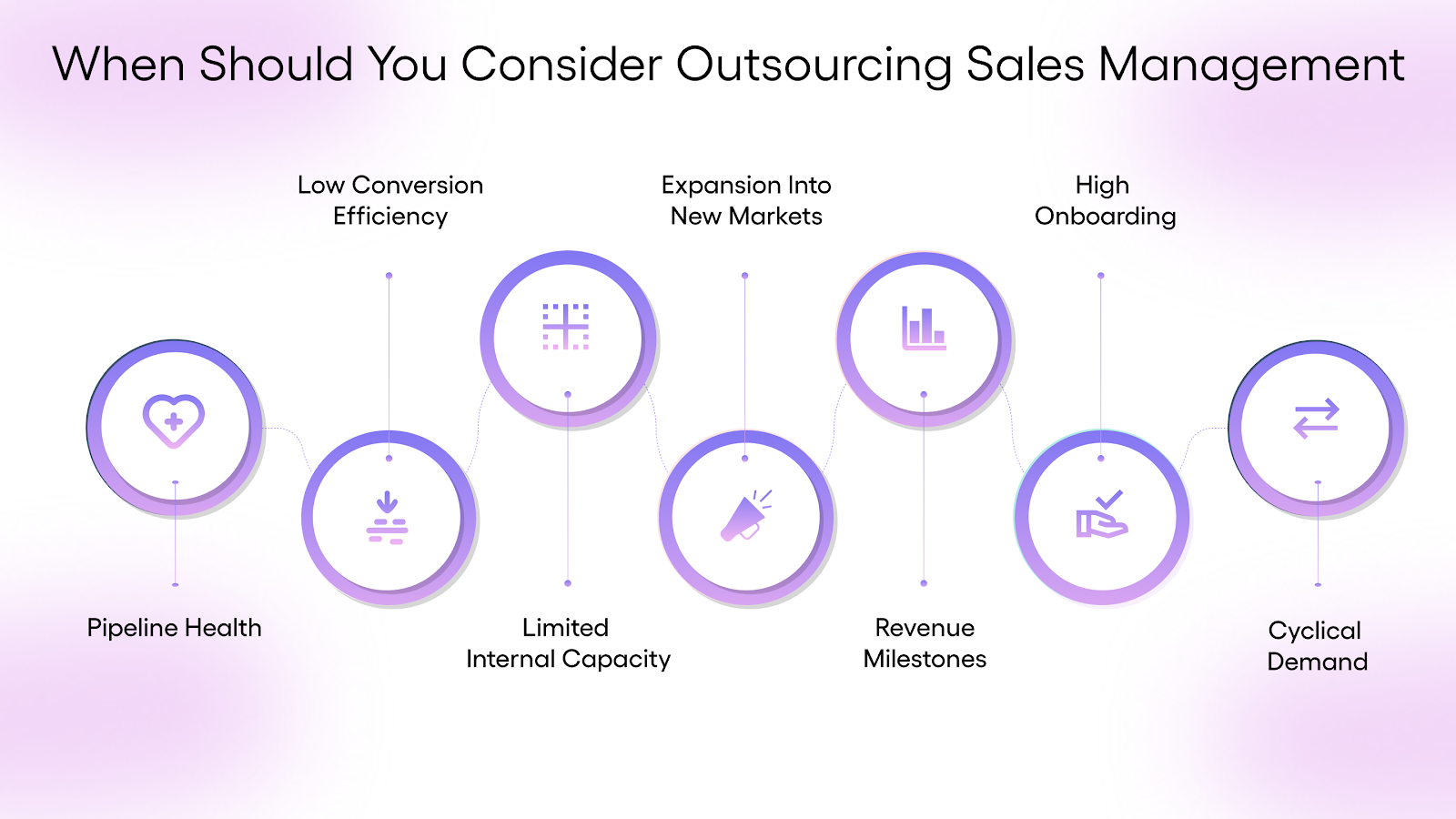
Outsourcing your sales management can unlock major advantages, but only when implemented at the right stage. Timing matters, especially for B2B SMEs operating with lean teams and ambitious growth targets.
If any of the following conditions apply to your business, it may be time to explore outsourced sales leadership:
- Unstable Pipeline Health
Lead generation is inconsistent or heavily reliant on a single channel, making monthly forecasts unreliable.
- Low Conversion Efficiency
Sales representatives are spending too much time qualifying leads instead of closing deals, which impacts win rates and productivity.
- Limited Internal Capacity
Your current sales team lacks the bandwidth to scale outreach, follow up, or manage a larger pipeline.
- Expansion Into New Markets
You're targeting unfamiliar regions or industries and need experienced professionals to build messaging and prospect lists quickly.
- Lagging Revenue Milestones
Despite marketing efforts, your monthly recurring revenue (MRR) is either flatlining or growing at a slower rate than projected.
- High Onboarding and Turnover Costs
Internal sales hiring is proving expensive, time-consuming, or unsustainable in the long term.
- Seasonal or Cyclical Demand
Your business faces demand surges during certain periods, and full-time hiring for short spikes doesn’t make financial sense.
If your growth is being slowed down by inconsistent execution, misaligned resources, or hiring bottlenecks, outsourced sales management can help you course-correct without delay. Knowing when to bring in external support is often the difference between reactive selling and predictable revenue.
How Outsourced Sales Management Works: Step-by-Step Process
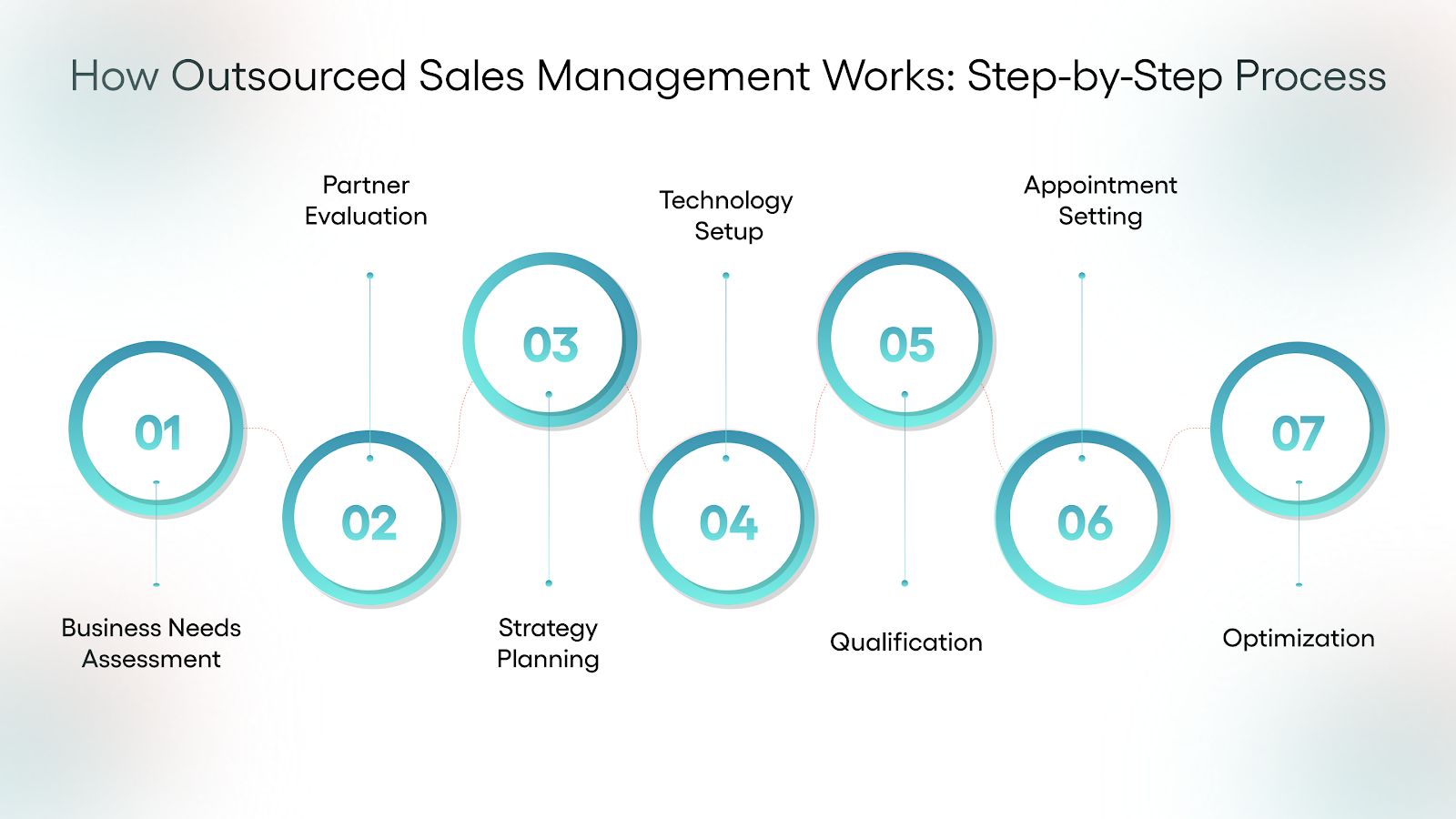
A successful outsourced sales engagement follows a structured, collaborative process. This ensures alignment between your business goals and the partner’s execution strategy from day one.
Here is a step-by-step look at how outsourced sales management typically unfolds:
Step 1: Business Needs Assessment
The process begins by identifying your sales challenges, target outcomes, team gaps, and budget scope. This helps define what responsibilities should be outsourced and what success will look like.
Step 2: Partner Evaluation and Selection
You research outsourcing providers with proven industry experience, strong processes, and transparent pricing. Case studies, client reviews, and a discovery call help validate fit and alignment.
Step 3: Strategy Planning and Goal Setting
Once a partner is chosen, both sides finalize the sales strategy. This includes defining the ideal customer profile (ICP), establishing messaging frameworks, setting KPIs, and outlining communication protocols.
Step 4: Technology Setup and Campaign Design
Essential systems are set up to track outreach, monitor responses, and manage lead activity, without overcomplicating the tech stack. Campaigns are crafted using tailored scripts and messaging frameworks that reflect the value proposition and resonate with the target market. Every element, from sender identity to follow-up timing, is optimized to improve engagement and drive conversions.
Step 5: Execution – Outreach, Nurturing, and Qualification
Dedicated specialists run targeted outreach campaigns, qualify leads, and nurture them based on predefined scoring models and buyer intent signals.
Step 6: Appointment Setting with Decision-Makers
Once leads are qualified, meetings are booked with relevant stakeholders from your prospect’s side, giving your internal team ready-to-convert opportunities.
Step 7: Reporting, Feedback, and Optimization
Performance is tracked in real time through detailed reports. Metrics such as email response rates, lead quality, conversion timelines, and MRR impact are reviewed regularly.
Each stage is handled by domain experts, including strategists, writers, SDRs, and data analysts. This division of labour ensures that your internal teams remain focused on product delivery and closing, rather than prospecting or process setup.
Outsourced sales management is not a one-size-fits-all solution. It’s a collaborative journey where constant alignment, data insights, and flexibility drive consistent revenue outcomes.
Also Read: How Outsourcing Can Transform Small Businesses
Choosing the Right Partner for Outsourced Sales Management
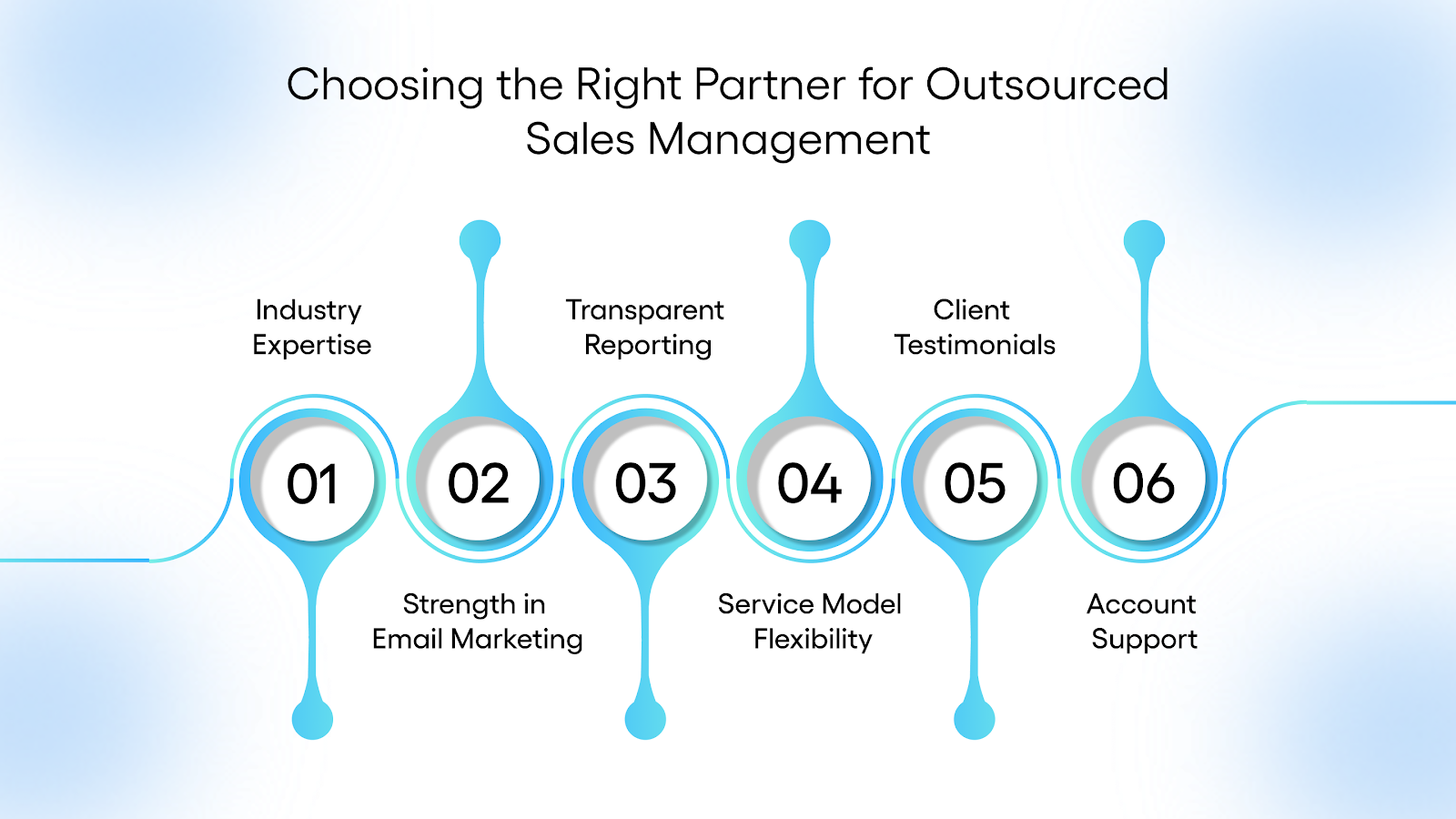
Outsourcing sales management only works when the partner is aligned with your industry, sales goals, and internal workflows. Choosing the wrong provider can result in poor lead quality, missed targets, and a wasted budget.
To ensure you select the right partner, assess them using the following criteria:
- Industry Expertise with Proven Outcomes
A good partner should understand your industry’s buying cycles, decision-making layers, and technical nuances. For example, MSPs often sell to time-starved IT heads and business owners. A partner familiar with this space can craft messaging that speaks directly to their concerns. Review the provider’s case studies and success metrics in your vertical to assess alignment.
- Strength in Email Marketing and Lead Generation
Email remains the backbone of most outbound sales strategies. The provider must demonstrate experience in managing high-volume, compliant campaigns across B2B segments. This includes crafting cold outreach scripts, managing sender reputation, performing A/B testing, and using email tools to track engagement.
Ask for examples of email sequences and performance benchmarks like open rates, response rates, and SQL conversions.
- Transparent Reporting and Performance Visibility
Your partner should provide regular updates and real-time access to lead pipelines, appointment statuses, and campaign key performance indicators (KPIs). Dashboards should include metrics such as delivery rates, meetings booked, and revenue impact. This transparency enables better alignment with internal teams and faster decisions.
- Service Model Flexibility
Outsourced sales is not one-size-fits-all. Choose providers who offer multiple pricing and delivery models, like pay-per-appointment or monthly retainers. Flexible contracts allow you to scale up or down without long-term lock-ins, especially important for growing businesses with shifting sales targets.
- Client Testimonials and Third-Party Proof
Strong partners can point to successful long-term client relationships. Look for testimonials that highlight return on investment (ROI), service quality, and ongoing support. Speak to existing clients to understand what working with the provider is really like.
- Dedicated Account Support and Onboarding
The right partner offers more than just execution. They guide you through onboarding, ICP refinement, messaging alignment, and campaign launch. A dedicated account manager ensures timely adjustments, feedback loops, and goal alignment.
A reliable outsourced sales partner integrates into your sales ecosystem. At TLM, we specialize in B2B demand generation for MSPs, tech firms, and service providers. Our clients benefit from industry-specific messaging, compliant outreach workflows, and transparent reporting that prioritizes MRR growth.
How TLM Supports Outsourced Sales Management for B2B Growth?
TLM (The Lead Market) supports B2B SMEs across North America, Canada, and Australia by managing the end-to-end sales pipeline, from lead generation to MRR impact. We bring nine years of email-first expertise to help businesses accelerate growth, eliminate pipeline inefficiencies, and focus internal teams on closing deals, not chasing unqualified leads.
Below is how The Lead Market delivers measurable sales outcomes through a structured outsourced model:
- Email-Based Lead Generation That Converts: TLM utilizes compliant, data-driven email campaigns to initiate conversations with key decision-makers. Our email marketing specialists design, test, and deploy outreach strategies tailored to each client’s ICP. We track engagement and response metrics in real time to ensure consistent lead flow.
- Sales Qualified Lead (SQL) Delivery: We do not pass generic contacts to clients. Every lead is vetted for decision-making authority, buying intent, and relevance to your services. This ensures that sales teams engage only with prospects who are ready for meaningful sales conversations.
- Precision Appointment Scheduling: Our appointment setting team uses verified lead data to secure meetings directly into your calendar. We coordinate time zones, qualify intent, and confirm the presence of decision-makers so your representatives only attend sales-ready calls.
- Demand Generation Across the Funnel: TLM runs multi-stage nurturing sequences to keep leads warm. We engage prospects with value-driven messaging, accelerating their journey from interest to intent. This helps maintain a strong, predictable sales pipeline across buying cycles.
- Industry-Specific Targeted Campaigning: Each campaign is tailored to the unique dynamics of its respective industry. For instance, MSP campaigns focus on reducing downtime and increasing security ROI, while staffing outreach prioritizes cost-per-hire efficiency and the impact on fill rates.
- Account-Based Marketing (ABM) for High-Ticket Deals: For clients pursuing enterprise or mid-market accounts, we offer ABM services. TLM builds hyper-personalized sequences, mapping out stakeholders and customizing messages based on role, function, and known pain points.
- Real-Time Dashboards and Campaign Insights: Clients get 24/7 access to dashboards tracking campaign health, lead activity, email engagement, and appointment progression.
TLM doesn’t just generate leads. We help B2B companies in the MSP, staffing, tech, and manufacturing sectors build a repeatable sales engine focused on Monthly Recurring Revenue. With our Pay-Per-Appointment and Monthly Retainer models, businesses gain flexibility, scalability, and predictable ROI.
Looking to improve your MRR through predictable, high-quality lead flow?
Schedule a Meeting with TLM’s experts to explore how our B2B lead generation, appointment setting, and account-based marketing solutions can fuel your sales engine.
FAQs
1. What kind of reporting should I expect from a reliable outsourced provider?
You should receive weekly and monthly campaign updates, along with real-time access to dashboards. These include metrics such as lead status, appointment count, email engagement, and MRR impact, allowing you to track ROI without guesswork.
2. Is outsourced sales management suitable for companies with complex or niche services?
Yes, especially when working with partners like TLM who offer account-based marketing (ABM). Niche offerings benefit from customized messaging, stakeholder mapping, and multi-touch email campaigns that target high-value decision-makers directly.
3. How long should I commit to seeing real revenue impact?
Most companies see early wins, like increased qualified meetings, within the first 30–45 days. However, for long-term MRR growth, a 3–6 month commitment allows for optimization, feedback cycles, and sustained pipeline building.
4. What happens if I need to scale up or down my outreach quickly?
TLM’s flexible pricing models (Pay-Per-Appointment, Monthly Retainer) allow you to adjust campaign volume, targeting, budget changes, or new go-to-market strategies, without service disruption.






